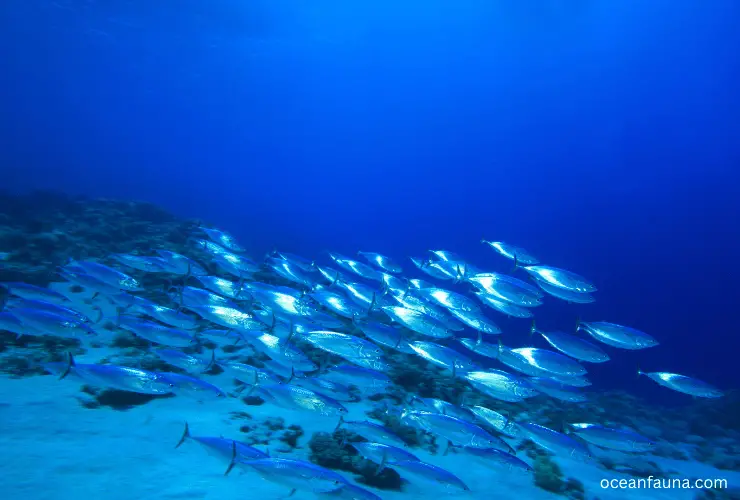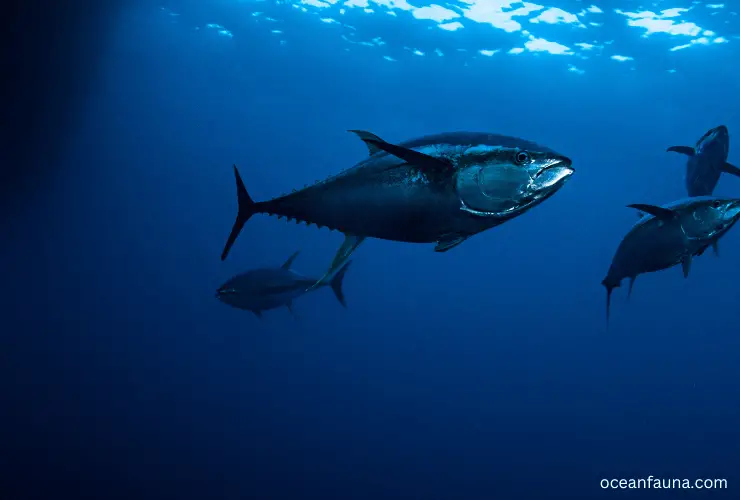Yes, sharks eat tuna when they get the opportunity. However, Mako Sharks, Tiger Sharks, Bull Sharks, and Great White Sharks mostly get the chance to capture it since tuna is so faster than most sea creatures.
In this article, we will have a closer look at how sharks prey on tuna.
Do Sharks Eat Tuna?
Whether or not a shark can hunt tuna depends on its velocity. Tuna is capable of swimming at speeds around 43 mph, making them almost impossible to catch for most sharks. However, many species have evolved to be fast enough that they will successfully capture their prey when the tuna is within close proximity.
Now a question comes to mind which sharks can catch tuna? Well, the number is not so big. Tiger, Mako, bull, and great white sharks are mostly known to catch tuna.

Tiger sharks and bull sharks share a maximum speed of about 20-25 kph, yet the Great White Shark can reach up to 56 kph in short bursts. The swiftest shark species is Mako, reaching an impressive 60 kph!
Therefore, although tiger sharks and bull sharks have to try harder to catch a tuna, this task is easier for great white sharks and mako sharks.
Sharks vs. Tuna: Anatomical Differences
Sharks and tuna are two of the most iconic ocean predators. While they share a common lineage, their anatomical differences are quite pronounced. Sharks and tuna differ in body shape, size, coloration, and swimming abilities.
Body Shape
Sharks generally have an elongated, torpedo-shaped body with a broad tail fin that provides power in swimming. They also have a distinct dorsal fin on their back which assists them in steering as well as stabilizing when moving through the water. In contrast to sharks, tuna has a much more compressed and curved body shape that is designed to reduce drag while increasing speed and agility when hunting or fleeing from predators.
Size
Sharks range in size from the dwarf lantern shark, which is only 6 inches long to the whale shark, which can grow up to 60 feet long! Tuna, however, tend to be much smaller than sharks; most species of tuna average between 3-6 feet in length.
Coloration
The coloration of sharks and tuna can vary greatly depending on the species, but sharks generally display darker colors, such as slate gray or black. Tuna can range from bright silver to deep blue or even yellow!
Swimming Abilities
Sharks are considered highly efficient swimmers due to their torpedo-shaped bodies combined with their powerful pectoral fins, which allow them to cruise continuously through the water while expending less energy than other ocean predators. By contrast, tuna rely on short bursts of energy; they use their caudal fin (tail) to quickly accelerate through short distances before gliding again at lower speeds with minimal effort.
Which Tuna Species Are Mostly Preyed Upon by Sharks?
While sharks aren’t known to hunt all species of tuna, there are a few varieties that they do target.
The most commonly preyed upon tuna species by sharks are yellowfin, skipjack, and albacore. Although the majority of tuna species are generally resilient to predation, these three species have been found to be particularly vulnerable.
Yellowfin tuna (Thunnus albacares) is a large oceanic fish that can range from 1-3 feet in length and weigh up to 400 pounds. Native to tropical and subtropical waters worldwide, these fish gather near the surface in large numbers, making them an ideal target for predators such as sharks.
Skipjack tuna (Katsuwonus pelamis) is another widely distributed species of fish that usually lives in the upper levels of tropical waters worldwide. They tend to feed on smaller fish and invertebrates near the surface, which makes them popular prey for sharks.
The last common type of tuna preyed upon by sharks is Albacore (Thunnus alalunga). This species is typically found in subtropical waters around the world and does not school together like yellowfin or skipjack. However, due to its size and tendency to feed near the surface, it remains a popular target for predators like sharks.
All three of these tuna species are staples of shark diets due to their abundance, nutritional value, and vulnerability while they move in large schools or feed near the surface.
Does Tuna Eat Sharks?
Tuna is known to predate on smaller, sluggish sharks, and some species of tuna have been observed actively hunting for them. For example, bluefin tuna and skipjack tuna have both been seen preying on spiny dogfish, a type of small shark commonly found in the Pacific Ocean. Similarly, yellowfin tuna and albacore tuna have both been known to consume small blacktip reef sharks in the Indian Ocean.
However, not all species of tuna share this behavior; larger species, such as bigeye tuna and great barracuda, generally prefer to feed on larger prey like mackerels and squids. In addition, due to the size difference between most tuna and most sharks, it is usually only the more aggressive or predatory species of tuna that are able to successfully hunt down and eat sharks.

As a result, while it is certainly possible for a tuna to consume a shark as part of its diet, it is actually quite rare in comparison with other types of marine creatures that do so more regularly.
In terms of anatomy and behavior, there are several key differences between sharks and tuna which further explain why they don’t commonly get eaten by one another. For starters, unlike a shark, whose skeleton is made up entirely of cartilage making it incredibly flexible yet also quite weak compared to other fish species, a tuna’s skeleton is composed mostly of bone, making it much stronger than its shark counterparts while also enabling it to swim faster and more efficiently through the water.
Can Tuna Fight a Shark?
Not all tuna can fend off sharks; only bluefin and yellowfin – are species regarded for their size, strength, and razor-sharp fins. These fish can reach up to ten feet in length with the ability to weigh a whopping thousand pounds! But even these giants stand little chance against some of the most intimidating shark species, like great whites, bull sharks, and tiger sharks, that are simply too strong for them.
Sharks pose a tremendous threat to many species of tuna since they are powerful predators capable of taking down even the largest prey. Sharks can range in size from the small cookie-cutter shark (which is just over a foot long) to the huge whale shark (which can be up to 50 feet long). They rely on their sharp teeth and powerful jaws to take down their prey with great efficiency.
However, the larger species of tuna have an advantage over other types of fish due to their thick muscles and fast speeds. When confronted by a shark, the tuna will use its body weight and razor-sharp spines on its fins and tail to fend it off.
In addition, these tuna also have remarkable endurance, allowing them to outlast their opponent by swimming away quickly while using evasive manoeuvres such as zig-zagging or diving deep into the ocean’s depths. Plus, they also have an excellent vision that gives them an early warning when detecting potential threats like sharks.
Overall, larger types of tuna, such as bluefin and yellowfin, can successfully fight off sharks if necessary; however, smaller species would not fare so well against these powerful predators.
What Are the Advantages To Sharks of Consuming Tuna?
The advantages to sharks of consuming tuna are numerous, as tuna is an incredibly nutritious food source for these oceanic predators. Tuna is rich in essential vitamins and minerals, such as Vitamin A, B-6, and B-12, magnesium, phosphorus, iron, and zinc.
The omega-3 fatty acids found in tuna can also promote healthy skin and joints in the shark’s body. Not only do these fatty acids boost the immune system and enhance mental health, but they also provide energy for long-distance swimming.
Moreover, the high protein content of a single tuna fillet provides enough nutrients for a shark to stay active for extended periods of time.

Tuna also contains important trace elements such as selenium, which is helpful in preventing cancerous, tumours as well as thyroid dysfunction in sharks.
Additionally, they can help with vision by providing sodium iodide, which helps protect eyes from sun damage when exposed to bright light underwater.
Finally, the high taurine levels found within a single fillet of tuna can help support healthy liver function and cardiovascular health while providing anti-inflammatory benefits.
Conclusion
Now you have an in-depth understanding of something remarkable: Sharks are not the only ones that eat tuna – sometimes, larger tunas can even prey upon smaller sharks. Because they swim so quickly, sharks can only catch them when they are within close range.


7 thoughts on “Do Sharks Eat Tuna? [Explained]”